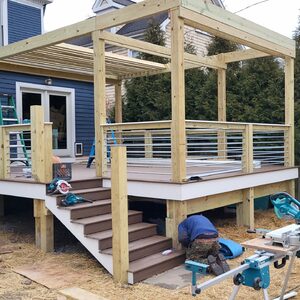I need to laminate some front steps on a curve. They are right out in severe weather conditions and the old treads rotted out in less tahn fifteen years. What i want to do this time around is to rip Trek or one of it’s competitors in this new fangled composite materials market into strips about an inch wide and laminate together to make up the curved step.
I usually do my curved laminations with red cedar or pines but Neither is best for an entry where lots of water and foot wear will hit it.
So what kind of glue would you use?
I tend to favor PL construction adhesive but I suspect it will suffer creep. The manufacturer rep said in a roundabout way that they did not recommend glueing the product but that if they wanted to glue it for their own project at home, they would probably use Gorilla glue.
How ’bout you?.
Excellence is its own reward!
Edited 11/21/2003 5:29:43 PM ET by piffin


















Replies
Piff .. Warm up the Trex and radius it as a stock unit without the glue up. I used a PVC heater / bender. I understand HOT (140*) water will get the same results.
Consider adding stringers to get 12"OC.
Did 1 set of steps with Trex and the flex will get your attention.
Put in a call to Pro-Dek.
Who ever invented work didn't know how to fish....
i would use epoxy....probably West system...
there is enough wood fiber in the Trex so it thinks and acts like wood..Mike Smith Rhode Island : Design / Build / Repair / Restore
I like IMERC's idea if it will work for ya.
I can tell you though that I've tried Gorillia glue, and it didn't hold too good. Give it a try on a test piece, let it dry for a few days, and test it. Mine seperated with moderate force.
Let us know what you end up using...
Another approach would be to find out what kind of plastic it is and whether there's a solvent for it that will do solvent welds like ABS or PVC pipe.
-- J.S.
It will be glued because it needs to look "as one" when finished.
I will probably try some test pieces before doing it for full production and let you know. The chemical weld is an intersting idea. I had planned to use heat to flex it and the stringers will be varying because at the top of three steps, they will be closer to center of the arc while at the bottom step, it hangs on a longer radius, so I will be cutting minor arcs like a chord of the circle to intersperse the stringers on the bottom and provide the underlying support.
So the big Q is what glue works best. Maybe it will be the West..
Excellence is its own reward!
There was an FHB article a few years back on building curved deck rails with Trex. I can't remember what glue they used, but it seemed to work pretty well.
Bob
I think a lot of the plastic is recycled polyethlene from grocery bags. That stuff is really hard to glue. I wouldn't bet that epoxy would work real well. Maybe melt it with a torch and stick it together?
IF it is polyethylene (PE) (and I don't know if it is), then you can heat weld it. Just like repairing downhill ski bases, the cheapest thing is to cut strips of yogurt containers or milk cartons or tupperware and light one end. The molten PE will drip onto your work pieces and weld them together.
If the pieces are cold, the molten filler material won't bond to the piece (i.e. won't melt the outer surface of the piece). Pre-heating the pieces to be welded with a hair dryer fixes that.
They make PE, PVC, etc hot air welding set-ups. Hot air pre-heats the pieces and melts the filler rod. Makes it as strong as the base material.
This works for LDPE and HDPE. Not for XLPE (aka PEX). The cross-linking is a chemical process joining the polymers together. You can melt it and make it flow once it has been cross-linked.David Thomas Overlooking Cook Inlet in Kenai, Alaska
I know Azec usually gets a chemical weld with pvc glue but it can be heat welded too. Anybody know how that process is done? Azec can be glued with gorilla even though it is a PVC.
I learned the trick of heat welding when I was ona road trip once and hit a major pothole, blowing my radiator out and shattering the plastic fan shroud. Guy took a soldering iron to it, but the messy look is definitely not what I'm after here.
If I were setting up a factory shop to produce a lot of this, I suppose I could find the right resistence wire and lay it into the joint and clamp everything up and then use a currrent to do the melt, but it would take a few prototypes to get it right..
Excellence is its own reward!
what i remember is gluing up an octagonal window casing with trex & West system..
and using west to glue trex bungs on a deck..
it's been a couple of years, but i think the epoxy found enough wood fiber to be
happy
Mike Smith Rhode Island : Design / Build / Repair / Restore
"it can be heat welded too. Anybody know how that process is done?"
When I fab'd large plastic things (1,000 gallon chemical process vessels with weird internals), we had a the following set-ups:
Heat bending: Two heat aluminium bars, one above, one below. Let the sheet plastic sit between them and, after a minutes, it bends nicely along that line. Because that line is soft and the rest of the sheet is normal hardness. Hold in place till it cools. (Clamps are nice at this point).
Heat welding: Hot air blowing out to pre-warm the pieces to be joined and, essentially, a hot glue gun feeding filler rod.
Also, we used a killer PVC glue. Really thick (more than Heinz 57, almost like peanut butter). Took 24 hours to set/cure but was as strong as the base material when cured. Harrington Plastics was one source.
Tap Plastics (West Coast only?) fabricates plastic stuff. They might know or at least have a mess of solvents and heat welding rigs to try out.David Thomas Overlooking Cook Inlet in Kenai, Alaska
Thank You, David.
The Harrington page is a slow load but I have already found the E6100 adhesive from Tap
http://www.tapplastics.com/shop/product.php?pid=129&
I am ordering a case to get it coming. Sounds like great stuff to have around even if I use another product on this one. I am also looking ou sites to find out the exact chemical names of these comnposites that I am dealing with..
Excellence is its own reward!
The trex special applications pdf speaks to bending curves in the material. Apparently at normal room temp you can tweak a 20' radius out of it and by going to 125°, you can take it to a 16' radius. This is in full widths. My tightest will be at about a ten foot radius but ripping to 7/8" makes it easy at the 50° we have today.
http://www.trex.com/products/installation/pdf/Special_Applications.pdf
In this same PDF, they speak of curved railings and suggest using a full piece for the top finished rail and underlying it by ripping and refastening strips. They give absolutely no hint how they think you should refasten those strips..
Excellence is its own reward!
http://www.specialchem4adhesives.com/resources/adhesionguide/index.aspx
You have to register to get into this site and it is so comprehensive that I am still finding my way around, but somebody else might benefit from it besides me..
Excellence is its own reward!
"great stuff to have around"
Yep. The coolest use of that stuff (i.e. use $0.15 worth of glue to save $40 of parts), is to make a tap in large diameter pipe or in a tank.
Say you need a 6x6x1/4" PVC tee to put a sample port or pressure gauge into a pipeline. You could buy a 6" tee, 6x4 reducer, 4x2 reducer, 2x1/2 reducer, 1/2x1/4 reducer, glue it all together and end up with something pretty ugly.
Instead, buy a 1/4" PVC female adaptor, drill a hole of its O.D. in the pipe (or a coupling) and glue it in. A day later, you have a nice looking part that is as tough as the pipe itself.
"find out the exact chemical names of these composites that I am dealing with"
Issac Asimov recommended reciting long chemical compound names to the tune of an Irish jig. Makes them easier to remember and makes you pretty memorable around the chemistry stockroom.David Thomas Overlooking Cook Inlet in Kenai, Alaska
Do you know if it is a polyurethene type adhesive? or some other chemistry?
I don't sing very well, according to my wife and daughter, but thesse composite decking materials are made with polypropylene. ( some others are HDPE)
The locator site I linked above provides a list of four types of adhesives that can work with this product. Polyurethyne glues (which include the PL Premium and the Gorilla Glue) came to the top of the list. After reading (more like browsing since I had to skim over the big words) the descriptions of them all with the attributes and limitations, it looks like the polyurethenes are the best for this application.
The Epoxies and the crazy glues are listed there too, as being possibilities.
Now an observation -
Isn't it amazing that the street knowledge of the members of this Breaktime Mastermind tended to lean the same way and come up with the same list that an intensive plastics search database provided?!?.
Excellence is its own reward!
i forgot about the pl premium... we used a lot of that gluing up GP PrimeTrim..
i'd probably go for that too, especially in terms of ease of use for your application..
it also has a longer life on your hands.. West wears off in about 3 days, PL Premium is still there a week laterMike Smith Rhode Island : Design / Build / Repair / Restore
Well, that's one comparison I can't make. I have always worn the latex disposables with West before this. Some reason I didn't think of them today. I have had my share of PL turn me black though..
Excellence is its own reward!
I guess one thing that Mike mentions appeals to me in this decision and that is the thicker body of tube applied adhesive for the verticle surface I will be working with. PL will hold that position but the colour of the excess will be unfriendly. The other product from TAP plastics appears as though it might be clear.
The West epoxy is so drippy that it will create problems of it's own.
BTW, here is the website for the correctdeck I am considering -
http://www.correctdeck.com/
Mike, Have you ever used this? It is made here in Biddeford, Maine.
Excellence is its own reward!
no, i've looked at Correctdeck at the JLC shows.. but i'm pretty happy with Trex... along the lines of "the devil you know"
on another point you raised... Fir T&G ?... look up Tendura... 3 1/8 face... 7/8 thick same profile as traditional Fir T&G... a slight grain so it will not be slick when wet..
i think i will push it on the next exterior T&G porch job i get....Mike Smith Rhode Island : Design / Build / Repair / Restore
piff... i took my own advise.. googled Tendura..
John Hyatt ( heard of him ? ).. says he don't like it..... but also sounds like he ain't used it..
he has researched it, though..
he likes Ipe' T&G..., which i've seen at Liberty Cedar...i'd like to know if my Bostich Flooring nailer will nail ipe' though ... i have SS. cleats for thatMike Smith Rhode Island : Design / Build / Repair / Restore
Tendura, I'll look into that.
BTW, here's the job this will be on - replacing the bottom three steps. I redid the top and rail a few years ago so some of you all have seen this before.
Excellence is its own reward!
I don't know - don't want to know - much about plumbing but now that you've taught me this trick maybe I can get me a license, LOL
I have made up a lot of compression gaskets on site with the appropriate caulk materials in similar situations in roofing and waterproofing. I also know very little about automotive but I would presume that Mikw Gabriel can comment whether there are liquid gasket materials developed for his world of wheels that do the same kind of thing there.
This whole investigation and afternoon Googling haas reminded me of an old TV ad back when I was a youngster, somnething about "Chemistry, changing that way that we live!".
Excellence is its own reward!
"an old TV ad back when I was a youngster, something about "Chemistry, changing that way that we live!" "
I paraphrase the Dow ad, "Without Chemistry, Life itself would be impossible." As, "Without Chemistry, toxic waste itself would be impossible." (That being my livelihood).
You know the TV ad, circa 1974, with the hamster swimming in a liquid like a fish, breathing the liquid? Just a chloro-fluoro-carbon with a lot of dissolved oxygen. Easy to do with a hamster and some refridgerate. But the hamsters all died (chemical pneumonia). If the hamsters had lived, the Navy was really interested in it for deep diving.David Thomas Overlooking Cook Inlet in Kenai, Alaska
Piffin,
I have your solution.
Just call up the guy who built that nifty cliff-side deck that you see in all of their ads. Ask him how he did it.
Problem solved.
Jon Blakemore
I asked the trex dealers(not lumber yards) were that deck was located and they did not know. Makes me think that ad was a photo shop hoax.
i talked to the trex reps... they told me that is a scale model.. if you look closely, you can tell..
if i remember the conversation.... the decking is actually about 1/4".. not the 5.5" of 12" = 1 ftMike Smith Rhode Island : Design / Build / Repair / Restore
As far as I know, the Trex ad is a model. A guy I worked with built it. His background was in set building for print and TV ads, and when he came to interview he brought an amazing portfolio of such things. He'd done very little carpentry before joining the company but was an amazing problem solver.
The rocks and water are at Big Sur CA. The deck is by Photo Shop or some such. That's what I was told by some guy that answered the phone at Trex.
Who ever invented work didn't know how to fish....
I read the same on this ofrum or maybe it was on the Splash forum.
Excellence is its own reward!
Piffin,
Trex has changed from when it was introduced. There is a higher percentage of wood fiber and less PE than before. I used it to make an exterior handrail, because no splinters and no finish needed. The brackets are at 3' centers or a tad under that. I put in a 60 degree scarf joint, and glued it with Titebond 2 after doing some tests. The joint is reinforced with screws, and is noncritical in that it falls directly on a bracket. Still, it is solidly together after 6 months in the weather (Southern California). The West System may be agood bet, as the stuff is at least half wood, and the particles are big enough that they are cut in half at a sawn edge. Whatever you do, make samples and destructive test them. I now view Trex as a sort of waterproof particle board that has its uses, but is not truly structural.
Bugle
Thanks for that real world experience and comments.
I would be more concerned with the thermal expansion stressing that surface scarf joint, but most anything would probably work OK with it.
Would PE be polyethylene? According to their website, the material is Polypropylene, which is similar apparently.
This Correctdeck material is nicer to my thinking. It is denser and more even in shape. One thing that always bothered me about the Trek is the irregularities. I also get the immpression that Correctdeck will hold its colour longer in the UV.
What I would like to find is a similar product that is practical in a T&G. We do a lot of decks with semi storage areas underneathe and presently use traditional Fir T&G but finding some starting to be rotted out after 12 - 15 years. Part of the reason is that the wood is not as close grained aas a hundred years ago and part because owners simply do not take the time to care for their homes like they used to. We've had those discussions about disposable homes in other threads hewre..
Excellence is its own reward!
Piff,
Remember this thread?
http://forums.prospero.com/tp-breaktime/messages?msg=34073.1
There might be something here to help you avoid using a procedure that doesn't hold up over the long haul. Paricularly post 14.
I've never tried this with Trex so I have no sure-fire ways to offer, but I think Imerc's onto it with the heat bend. If I recall correctly, Tim bent his cold and the lams didn't survive so well.
Knowledge is power, but only if applied in a timely fashion.
Edited 11/20/2003 9:43:20 PM ET by GOLDHILLER
Piff,
Don't know if this will help, but reading through the thread made me think of a catalog over in the reading room. Everything you ever wanted plastic - bottles, caps, etc. Even has sheets, rods, channels, etc. for fabrication. They also have plastic welding kits and welding rods. Here is their website.
http://www.usplastics.com
or 1-800-537-9724
Doc (Morris for the folks that need the real name ;)
A shortcut is the longest distance between two points.
Piffin; I am fairly doubtful that you will find a glue that will cut the mustard. If it were me I would use mechanical fasteners. I am thinking lay the things out and mark for a set of through bolts (maybe 12" to 18" OC) then glue with gorilla glue (mainly as a waterproof sealer) and staple each ply as you glue it up (between the bolt marks only). That way you will have the glue the bolts and the staples ... it oughta hold together! Can you tell that I am one of those guys that tends to overbuild? Seriously though I think that if you do it this way it will hold up. Otherwise it's a gamble. That's how i'd do it anyways.
Sure, it's a gamble. That's what us guys in the trenches are all about - but we bet with the house, not against it, keeping the oddes on our side.
I spent the morning in the shop ripping strips to find the right tolerance for bending and then using those strips to do some test laminations with PL Premium, Gorilla Glue, West system Epoxy, PVC glue, and even Titebond 11 just for giggles. I did these with both Trex and with a new (to me ) competitor called Correct Deck.
can anybody guess what colour my fingers are?
I have some initial imporessions that I'll keep to myself for now and repoprt back in a day or so when I try to knock them apart.
BTW, The Correct Deck material seems harder and stiffer. Trek is a thicker material but delflects easier. The tablesaw prefered ripping the Trex too..
Excellence is its own reward!
@Piffin, I'm about to embark on a quick mending job on a piece of Trex that was cut off accidentally. Nothing major like you were working on, but, as they say, knowledge is power. How did your experiment turn out? What held and what failed?
I wish I could help you but I don't have the answer. This is an 18 year old thread and Piffen and the other guys are just distant memories. Trex recommends bending with heat.